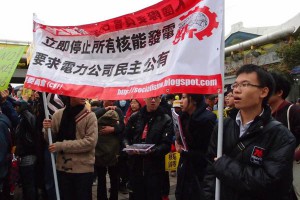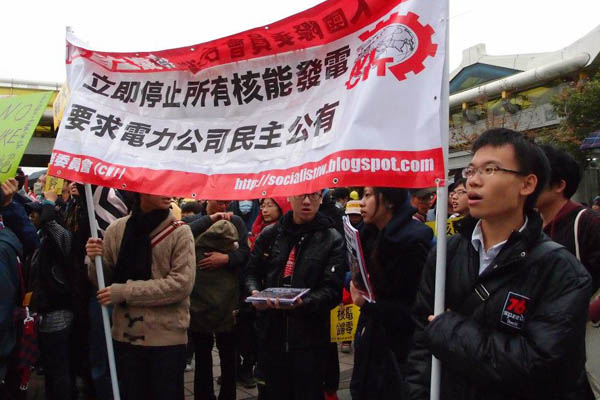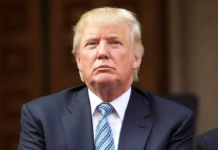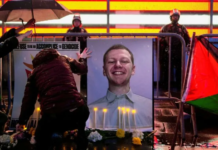Anniversary of Japan’s twin disasters and Fukushima meltdown sees nuclear capitalists back on the offensive
Vincent Kolo, chinaworker.info
“We must close down all nuclear power plants… We demand the democratic public ownership and control of Taipower [Taiwan’s power company].”
So said Hsiang-yu Hsieh, of CWI Taiwan, in his speech to yesterday’s big anti-nuclear demo in Taipei. Organisers from the Green Citizens’ Action Alliance estimate the turnout at over 5,000. The CWI section in Taiwan was one of more than 50 groups involved in planning the march, which commemorated the first anniversary of the biggest disaster to hit Japan since the Second World War. The anniversary was marked with similar anti-nuclear marches in Japan, France, Germany, Switzerland, Spain, Belgium and Australia.
On 11 March last year, a 9.0-magnitude undersea earthquake sent a massive tsunami crashing onto northeastern Japan, claiming 19,000 lives and crippling the Fukushima Daiichi nuclear plant. The worst nuclear disaster since the 1986 Chernobyl catastrophe became a fact. One year later, 340,000 people are still living in temporary accommodation, with over 160,000 of these evacuated from the area around the Fukushima plant. Tens of thousands turned out for anti-nuclear protests in Japan yesterday, including around 16,000 in the city of Koriyama, 60-km from the Fukushima plant.
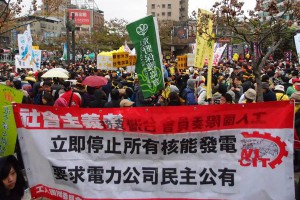
Taiwan’s ‘Nuke 4’ scandal
Yesterday’s protest march in Taipei demanded ‘no nukes’ – the scrapping of all nuclear power plants in Taiwan. Some marchers carried photos of their own funeral to symbolise the effects of a nuclear disaster, while others carried green paper windmills symbolising clean energy. An important issue was nuclear dumping on the island of Lanyu (Orchid), home to the indigenous Tao people who have been fighting the nuclear industry for three decades. There are over 90,000 barrels of nuclear waste stored on the 45-square-kilometer island. Following numerous health scares, the islanders accuse Taipower of a cover up.
Taiwanese protesters are especially concerned over the ‘Nuke 4’ or Lungmen nuclear power plant in Gongliao, the island’s fourth, which is scheduled to open in 2016. The project has been dogged by controversy from the start. Taiwan is highly prone to earthquakes – it sits upon the West Pacific Rim earthquake zone, the same as Japan. Taipower, the state-owned power company that is building the plant, which has been hit by repeated delays, has gone massively over budget. There is no such thing as a safe nuclear power plant, but the design of the Lungmen plant – a ‘hybrid’ adapted by Taipower engineers from American and Japanese designs – has caused intense debate with critics calling it a “patchwork”.
“Such a practice is abnormal and worrisome,” a spokesperson for Green Citizens’ Action Alliance said. “[This] has caused a lot of integration problems and entailed endless modifications.”
In an opinion poll conducted just after last year’s earthquake in Japan, 58 percent wanted the Nuke 4 project abandoned. The Lungmen plant is located just 40-km from central Taipei, a metropolitan area of six million people. Two existing nuclear plants are even closer. At Fukushima, the Japanese government established a ‘voluntary evacuation zone’ covering a 50-km radius from the stricken plant. All within a 20-km radius were ordered to evacuate. A similar accident at one of Taiwan’s nuclear plants would have unthinkable consequences.
Nuclear industry fights back
Despite massive opposition to nuclear power manifested in many countries – notably Germany, Italy, Japan and India – following last year’s disaster, the highly profitable and government-protected nuclear industry is again gathering momentum around the world. “The train hasn’t been derailed, the progression of the train may have slowed, but it remains on track,” said Vincent de Rivaz, a director of French nuclear giant Électricité de France.
The World Nuclear Association reports that 60 nuclear reactors are currently under construction globally, with 163 more on order or planned. These figures are virtually unchanged from the situation reported a month before Fukushima, in February 2011, which showed 62 reactors under construction and 156 on order or planned. As The Wall Street Journal comments, “The numbers belie the perception that the nuclear power industry was stopped in its tracks after the meltdown at the Fukushima nuclear plant.”
Japanese companies, who authored the Fukushima disaster, occupy a leading role in this renewed global nuclear offensive. “There’s been a severe backlash against nuclear-plant construction in Japan, but globally, demand for nuclear power is not declining,” declared Hideaki Omiya of Mitsubishi Heavy Industries. The three Japanese makers of nuclear plants are all reporting brisk business: “Toshiba Corp. aims to sell 25 more plants by 2015; Hitachi is targeting sales of 38 new plants by 2030. And Mitsubishi says it expects just minor delays in meeting a goal of selling two plants a year through 2025.” (Wall Street Journal, 11 March 2012)
Whereas in Japan and some other advanced economies such as Germany and Switzerland, there’s a shift away from nuclear power, this is not the case in developing economies. Especially in mainland China, which has plans to build over 100 nuclear reactors and become the world’s leading nuclear power generator by 2020, the Fukushima effect has proved to be temporary. At this week’s National People’s Congress (NPC, China’s yearly ‘parliament’), nuclear industry chiefs told the media that the ban on building new nuclear power plants imposed one year ago will soon be lifted. As the Wall Street Journal noted, “The future growth of nuclear power hinges in large part on Beijing.”
China’s nuclear woes
This is despite mounting opposition to nuclear power inside China on safety and environmental concerns. Critics, including many academics within the ruling party-state have dubbed the government’s plan the “Great Nuclear Leap Forward”. There’s even the case of a local government in Anhui province, which in November last year filed a petition with the provincial government seeking to stop the construction of a new nuclear power plant.
China lacks trained technicians and a national regulatory framework for such a rapid expansion, they warn. Given the appalling safety records of industries like construction and coal mining, and the state’s obsessive secrecy in all matters, the fears among ordinary citizens are understandable. This is especially the case in regard to nuclear waste, some of which remains deadly to humans for 250,000 years. The Wenzhou high-speed train disaster, which killed 40 people in July last year, also serves as a warning. Like the nuclear industry, this involved costly ‘state-of-the-art’ technology in a prestigious ‘showpiece’ industry. Both the nuclear and high-speed rail industries rely on national adaptations of advanced imported technology.
China and Asia are emerging as the future frontline of the anti-nuclear struggle. Vietnam, Bangladesh, Malaysia and Indonesia all have plans to develop a nuclear industry. In addition to China’s mega-expansion plans, South Korea, India, Taiwan and Pakistan all have new nuclear plants under construction. In the immediate aftermath of the Fukushima meltdown, many of these governments were forced onto the back foot and announced a slower, more cautious approach. But today the momentum is picking up again.
Even industry insiders have raised questions about this new global trend. “I’m worrying about the export of nuclear reactors to the Third World, like Vietnam, Thailand, Indonesia,” Yi-Bin Chen, director of the Department of Nuclear Regulation at Taiwan’s Atomic Energy Council told the Wall Street Journal. “I always say to my Japanese people that it’s immoral to export your Japanese reactors to Vietnam – they just do not have the infrastructure to operate it.”
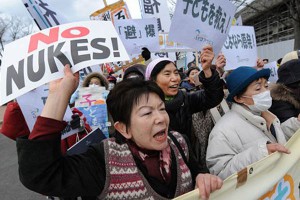
Reckless neo-liberal capitalism
One year on, the Fukushima disaster still casts a long shadow over Japan. The government’s response can be summed up as too little, too late. From the outset, independent experts criticised the government’s 20-km evacuation zone as inadequate. US nuclear expert Arnie Gundersen is one outspoken critic. He flew to Japan within days of the earthquake and tsunami. He says that while he was appearing on CNN calling Fukushima a Chernobyl-like Level 7 disaster, Japanese government spokespeople were still saying it was only a Level 5. The government was later forced to upgrade Fukushima to Level 7.
“The net effect is that by ignoring the fact that this was as severe as Chernobyl they put a lot of lives at risk and only time will tell what the exact number is,” Gundersen told CTV News (11 March 2012). “Over the next 20 years we’re likely to see a million cancers, but they have a latency period so we haven’t been able to see those yet.”
Even more shocking is the role of the privatised energy company TEPCO – Asia’s largest utility – which owns the Fukushima Daiichi plant. Initially the company wanted to save its ‘investment’ and so delayed flooding the plant with seawater, thereby exacerbating the disaster. Later, TEPCO executives wanted to pull out all emergency workers at the plant, an act that would have necessitated the evacuation of the Tokyo region. The struggle to ‘control’ Fukushima was fought largely by sub-contracted casual labourers under the company’s outsourced employment structure. These heroes of Fukushima for the most part do not receive pensions or medical insurance from the company.
Former Prime Minister Naoto Kan did belatedly announce measures to rein in the nuclear industry, halting plans for 14 new reactors. But his successor, Yoshihiko Noda, has performed a u-turn on this issue, giving in to the demands of the nuclear capitalists. Bloomberg correspondent William Pesek, who lives in Tokyo, accuses Noda of a cover up, and asks why nobody is going to jail. The government instead calls on all Japanese to ‘share the pain’.
Need for socialist alternative
The struggle against nuclear power is part of the wider struggle to save the environment and prevent the profit system from destroying our world. Nuclear power has been touted as a ‘clean’ alternative to fossil fuels, which of course it isn’t, as the problems of ‘disposing’ highly toxic nuclear waste testify. The Fukushima disaster, and continuing reckless expansion drive by the global nuclear industry, shows the energy industry cannot be left under the control of capitalism.
The examples of state-run power operators as in Taiwan show that state-ownership along capitalist lines merely reproduces similar problems of mismanagement and environmental vandalism as in privately-owned utilities, with profits put before public safety. These state-owned companies should be de-listed from stock markets and placed under democratic control and management by the workforce, consumers and the wider working class. We need a socialist energy policy to shift the economy over to clean energy sources such as wind and solar power. This can only be acheived with genuine public ownership and control of the major companies and a democratic plan of production.
